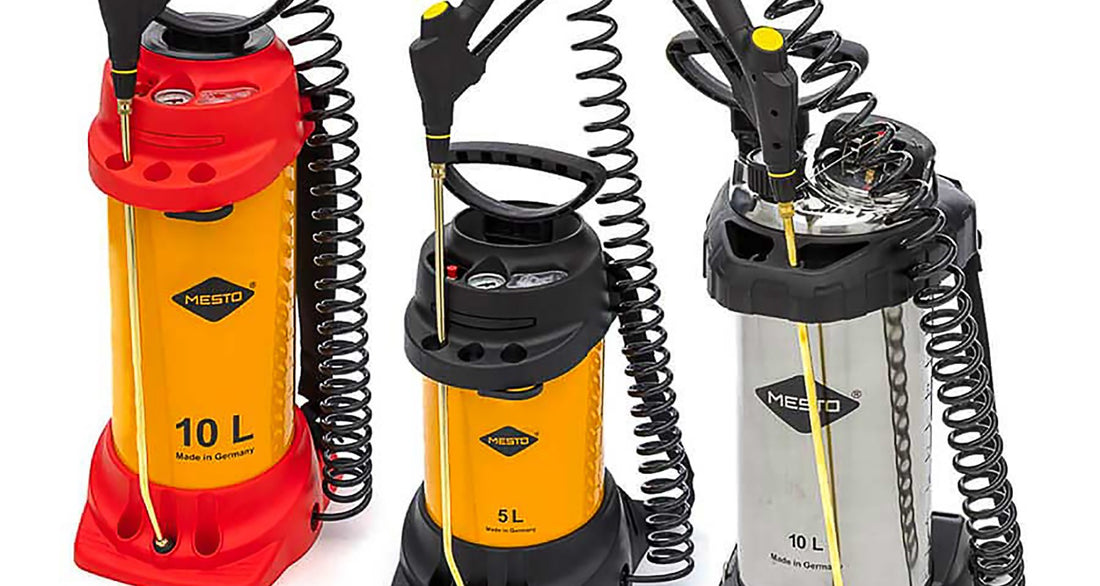
How to Choose the Right Sprayer for You: A Beginner’s Guide
Share
Whether maintaining a healthy and vibrant garden, or spraying industrial chemicals, having the right tools can make all the difference. Many people research intensely into what they’re applying but not how they’re applying it. One essential tool that often gets overlooked is the sprayer. Whether you need to apply chemicals, paint, herbicides, fertilizers, or simply water your plants more efficiently, choosing the right sprayer can greatly impact your application success. But with so many options available, where do you start? This beginner’s guide will help you navigate the world of sprayers, so you can.
- What is your sprayer’s purpose?
We offer full ranges for many different uses:
- Garden & Home Maintenance: from patios to roofs, trees to shrubs, all areas of your home and garden can be treated.
- Farming/Pest Control: whether professional or amateur, these sprayers are designed for the safe and effective application of pest control and specialist disease control.
- Chemical Use: from foaming chemicals to degreasing & biocides, we have specialist alkaline, neutral and acid-resistant sprayers to safely apply your chemicals.
- Professional Cleaning: reliable, long-lasting, quality sprayers for prolonged use, and easily customised to suit your preferences & reduce wastage.
- Manufacturing & Construction: whatever your business, our range of sprayers can be matched to your needs.
- Our Different Types of Sprayers
Before diving into specific models, it’s important to understand the different types of garden sprayers available.
- Handheld Sprayers: These are small, easily portable sprayers that are ideal for spot treatments, spraying into small or confined spaces and maintaining small gardens and patios. They usually hold between 1 to 2 litres of liquid and are operated by a manual pump.
- Pump Sprayers: Also known as compression sprayers, these are the most popular type for home gardeners. They come in various sizes (from 4 to 10 litres) and are operated by manually pumping a handle to build pressure within the sprayer tank.
- Backpack Sprayers: These sprayers are worn on your back, allowing for greater mobility and comfort, generally used to treat larger areas such as municipal gardens, grassland, driveways and car-parks. They have a higher capacity (usually 12-20 liters) and can be pump-operated or battery-powered.
- Battery-Powered Sprayers: Ideal for those who prefer less manual effort, battery-powered sprayers offer consistent pressure and are available in handheld, backpack, and wheeled models. They are particularly useful when trating larger areas.
If using for the home & garden:
- Consider Your Garden’s Size and Layout
The size and layout of your garden are crucial factors in choosing the right sprayer. For small gardens or spot treatments, a handheld or small pump sprayer will suffice. However, if you have a larger garden or one with intricate layouts (like winding paths or raised beds), a backpack sprayer might be more appropriate. The greater capacity and ease of movement will save you time and effort.
- Think About the Sprayer’s Purpose
What do you intend to use the sprayer for? Different tasks may require different features:
- For Pesticides and Herbicides: Precision is key. Look for a sprayer that allows you to control the spray pattern and flow rate. This helps ensure that you only target the areas you need to treat, reducing waste and potential damage to your plants.
- For Fertilizers: Uniform coverage is important when applying liquid fertilizers. A sprayer with a consistent pressure mechanism (like a battery-powered sprayer) will help you apply the fertilizer evenly across your garden.
- For Watering: If you’re using the sprayer to water delicate plants or seedlings, opt for a model with a gentle spray option to avoid damaging young plants.
- Evaluate Ease of Use and Comfort
Especially for larger areas, the sprayer's comfort and ease of use are important considerations. Backpack sprayers are generally more comfortable for extended use because they distribute weight evenly across your back. Our padded straps and ergonomic designs reduce the strain. If you opt for a pump sprayer, make sure that you are comfortable and that it is easy for you to operate.
- Customise
Once you have found a sprayer that suits your requirements, and evaluated the comfort levels you desire, you can now customise your sprayer to suit you.
- Back straps: You can make almost any of our sprayers into backpack sprayers with our back strap accessory.
- Trolley: For ease of use around large areas, quick spraying, or to reduce the weight carried, you can secure the sprayer onto one of our trolley accessories to wheel around.
- Nozzles: We have an array of nozzles for all different type of spray. Chemical resistant, plastic, metal, as well as all different shapes and sizes to suit your needs.
- Lances: From 43cm all the way to 5.4m, customise your sprayer reach with our lance extensions and telescopic lances.
- Shields: Make sure you’re spraying exactly where you intend to use your product the most efficiently
- Consider Maintenance and Spare Parts Availability
Like any tool, garden sprayers require maintenance to stay in good working condition. We are a strong believer in ‘repair don’t replace’ and therefore supply:
-
Spare Parts:
- Replacement Seal Kits
- Nozzles
- Hoses
- Batteries
- Fleece Pads
- Pumps
- Valves
- Spray Clean: To clean your sprayer frequently to avoid corrosion or build up of product, and keep it safe to use when changing products
- Spray Pattern Indicator: To use your sprayer as precise as possible, reducing the over use of the sprayer.
extending the life of your sprayer.
- Set a Budget
Finally, consider your budget. We have a large range of pricing depending on your needs. Consider:
- Frequency of Use: If you are planning on using your sprayer once a year, you don’t need the most high end sprayer, but if you will be using it every few weeks or more frequently then a more durable, higher cost sprayer would be worth your money to ensure it lasts and continues to work perfectly over the years.
- Durability/Chemical Resistance: Usually the more durable and resistant your sprayer is the higher its cost. For more stable and stronger the materials, the price has to increase.
- Manual or Electric: Our manual sprayers are more affordable than the electric as they are more physically demanding. If you are comfortable with using some elbow grease then a compression sprayer can save you some money, but you can’t have more ease of use than with an electric sprayer.
While it’s tempting to go for the cheapest option, remember that quality and durability are important. It’s often worth spending a bit more on a sprayer that will perform better and last longer.
Conclusion
Choosing the right sprayer might seem daunting at first, but by considering the size and layout of your area, the intended use, and your ease of use, durability, and maintenance requirements, you can find one of our model that fits your needs perfectly. Investing in the right sprayer will not only save you time and effort but also help ensure that your spraying thrives.
